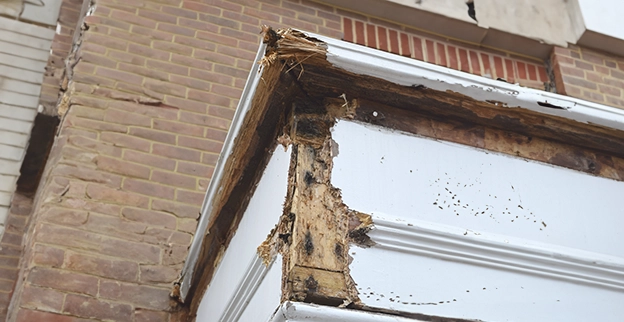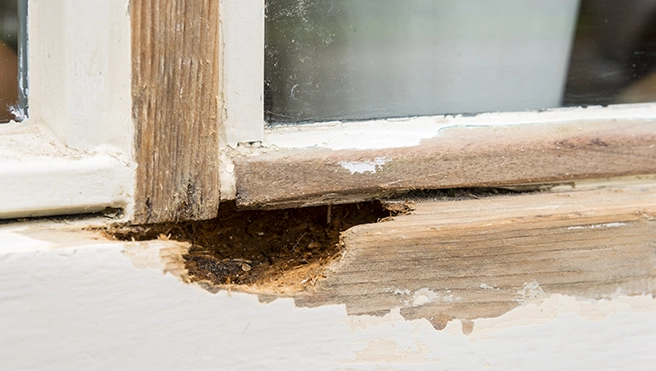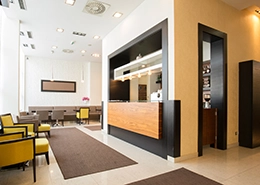Every year, wood rot, also known as wood decay, decimates many hectares of forest, which is caused by various fungal species such as brown rot, soft rot, and white rot. A fungus invasion will cause wood to appear discolored, wither away, and have a light, soft, crumbly, or powdery appearance. Conks, or fruiting structures, will form along the trunk and branches of diseased trees on the forest floor, and mushrooms may begin to grow at the base of the trunk or in areas where the tree has been injured or damaged.
Because the degradation process takes many years, you may not notice that your home's facets are deteriorating until it is too late. Diseased and dead branches are removed in the natural world, while young trees are wrapped to protect them from rot.
Deck, fence, siding, fascia, and window sill repairs are among the locations that are prone to wood rot in your house. No matter how severe the wood rot is, it is best to take care of it right away.
Our Professional Fairfield County, CT, Wood Rot Repair Services
However, in the real world, it takes a little more effort because your Fairfield County, CT, handyman must completely remove any rotten wood before attempting a repair, which is typically done with a fake replacement such as softwood polyester or by applying a wood patch. Any damp wood component that exceeds the 20% moisture threshold begins to deteriorate at the core and quickly spreads out.
In either case, we would not dismiss a wood rot repair outright because doing so could result in long-term structural damage, your home collapsing beneath you, and long-term negative health effects from mold and mildew growth. To make matters worse, since wood rot damage isn't regarded as abrupt or accidental, many standard home insurance policies don't cover it.
Types Of Wood Rot
Dry rot or brown rot: Dry rot wood is more prone to drying out because the fungus that causes it enters the wood and destroys the cellulose, causing shrinkage. As a result, timber supports for large objects like laminate, decks, and ceiling beams will begin to deteriorate. because wood rot is contagious. Here are a few indicators of dry rot:
- Damp or decaying timber
- Fine and fluffy white mycelium, a thick network of fungal threads, which grows from a single spore
- Deeper cracks in timber brain
- Brittle or crumbly wood
- Soft, fleshy fruiting bodies
- Discolored patches of orange-brown spore dust
- Odd or musty odors
White Rot: Although less common, wood is made of lignin, a polymer that binds the cells of the wood together to give it its inherent stiffness. Furthermore, once the fungus has easily entered the wood, it consumes the lignin and strips away the deeper hues, leaving a softer, sponge-like texture behind.
Soft Rot: Fungus and bacteria penetrate the secondary cell walls of wood in soft rot, which decomposes wood much more slowly than dry rot or white rot. Soft rot, in essence, attacks the cellulose first before devouring the lignin in a slow but sure manner. Although it is less dangerous than its cousins, leaving it as is is inconvenient because eventually enough will accumulate to compromise the structural integrity of your property.
Our Verified Installation Process
Wood rots when exposed to moisture from a leaking pipe caused by a sewage backup or overflowing gutters that splash on your home's siding. Surprisingly, there are simple ways to remove and replace rot, such as epoxy, wood filler, or wood patches, making treating wood rot simple. Here are some of the steps we take to repair wood rot with epoxy:
- Remove And Discard: By carefully chiseling away at the edge of the rot with a hammer's claw, our skilled technician will entirely remove the area that is home to the loose piece of decaying wood. We shall cautiously apply pressure so as not to harm the sound wood in your immediate vicinity.
- Router Away: We'll remove any remaining rot by using a router tool and a V-shaped bit to guarantee that the strong, healthier wood underneath is exposed. This step is essential because any rot residue that is left behind can contaminate and start to spread.
- Sand It Off: Any remaining residue on the wood's surface will be scraped off using a paint scraper or coarse sandpaper so that any additional coats or patches we apply will easily adhere to the smooth and clean surface.
- Time To Coat: Next, we'll generously treat the selected region with a few coats of wood restorer. Before moving on to the final steps of patching the area with an epoxy solution, we'll let it dry for at least two hours. We'll let it dry for a few minutes between coats to allow it to set.
- Bonding: Now we’ll paint the wood with a bonding agent using a brush.
- Epoxy 2.0: Then we’ll apply epoxy to fill out the entire rotted area by mixing both parts of the epoxy until there is a solid color using a gun applicator.
- Shape Up: With a putty knife, we will now shape the epoxy and gently press it against the edges and into the crevice of the rotten region to set it in place. To make the epoxy solution's edges and corners match the existing wood and create a smooth, level surface, the surplus will be carefully scraped off.
- Set and Sleep: We'll proceed to sand, prime, and paint it over once the epoxy has dried completely, which will take at least 24 hours. Priming and painting are essential for any outside fixtures, like your deck and fence, because of exposure to sunlight.
- Wood Patch: This is a backup or alternative method for repairing wood rot. As you can see, it is complicated and necessitates dexterity and accuracy that can only be provided by a Fairfield County, CT, handyman. It is also not something that should be attempted by inexperienced people because if any step is missed, the rot will quickly reappear.






